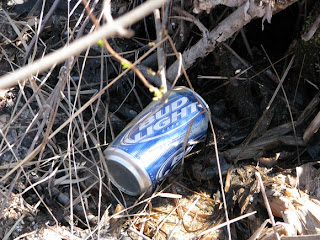We visited three more possible vernal pools over the weekend. Even though only one of the locations was actually a vernal pool, the "research photographer" (G.) had plenty of things to take pictures of while L. and I recorded observations.
Part of being our team's photographer was getting close-up photos of things we found. This meant G., who thought initially that she was going to be able to avoid mucking around in the water, had to do just as much of it as L. and I to get the photos we needed for our data forms. For instance, we spotted a large frog and needed a close up photo to see its markings so we could determine what type he was at home (we aren't so great at frog identification in the field).
We identified him as an American Bullfrog. He was found in a wetland area that we confirmed was not a vernal pool.
At our next location we finally made our own confirmation of a vernal pool! But, we are not sure it is "significant" for this research project based on all the species beyond typical vernal species we found at this location. A lot of wetland species prey on vernals so vernal species aren't likely to breed successfully in large enough numbers to be significant in this area. We're going back to this location in a couple of weeks to count salamanders (once their eggs start to hatch) and wood frogs (they're a bit elusive once hatched) to better asses things. Then we're leaving it to the UMaine researchers to make the final call based on the Project Data Forms.
These are spermataphors and are indicators that this is vernal pool activity. They are easy to miss unless you know what to look for. The girls were excited to check this off on our Project Data Form.
L. gets the credit for finding the spotted salamander egg masses. She was quite pleased with herself for seeing them first.
We also found some species that prey on vernal pool species like these large tadpoles.
And G. spotted these water beetles/bugs and thought they were kind of creepy looking up close. (If you know exactly what these are let me know.)
Unfortunately at our confirmed vernal pool, we also found quite a bit of trash and that was a bummer.
I emailed a couple of other research "teams" (there are several 4-H families with children participating in this project -- it's that UMaine/4-H connection that keeps us all so well-informed about interesting programs) and each team said they had more "strike-outs" than actual vernal pool identifications like we did too. About 1 in 5 of the maps each team was given was actually a vernal pool.
After the research photos were taken at each location, G. had some fun by taking advantage of the sunny day to get some shadow and reflection shots.
At our last area to evaluate this particular day, the elderly landowners were outside. We identified ourselves as being with the vernal pool project and they happily showed us their pond. It was not a vernal pool, which only took about 5 minutes to determine (we're getting pretty good at this stuff now), but we spent over an hour with the couple. They chatted about the history of their land (they own over 50 acres) and the creation of their pond. Then they insisted that we come in to their house to see old photos of their lands before they planted the 30,000 trees on it back in the 1950s.
I tried to decline their kind invitation - we were all covered in muck and sweat from our day of research - but the couple did not seemed fazed by our less-than-fresh odor and firmly insisted we go inside.
Once inside we found ourselves involved in a full tour of their 1800s home and a history lesson about the area.
They were a lovely couple and the girls very much enjoyed the impromptu visit. But this experience, as well as several chats with other landowners while visiting other locations, brought the point home that environmental scientists are also builders of good-will as well as educators. That in order to work to protect certain types of land and species, scientific researchers need to make compromises and work with (not lecture to) landowners about the importance of protecting the habitat/species on their land. Taking a hard-core stand in either direction (a "save the wetlands at all costs" vs. "fill in wetlands to get government off my back" attitudes) is not going to get the job done. It was a good lesson for the kids to see the real-life "politics" of research projects in action (and meet some really nice people) during this project and to know that finding a middle ground on both sides (researchers and landowners) is important for protecting the environment.
Monday, April 27, 2009
Subscribe to:
Post Comments (Atom)










No comments:
Post a Comment